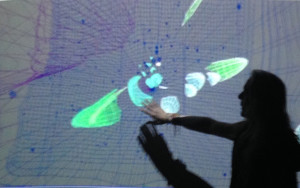Simulating the Universe
Instructor: Carter Emmart
Inside the Dome:
The Hayden Planetarium is spectacular. Touring the universe in the dome with Carter was fantastic. I am looking forward to seeing what the next generation of interactive visualization will look like.
Day 2:
The computer industry (integrated circuits, etc) were developed around the apollo program. Himawari 8 is providing some of the best images of full earth, animated, full color. The first interplanetary missions had very poor imaging. Film => digital => film. Early visuals were assembled as physical mosaics. Currently there are some areas of Mars that have been captured in very high resolution (less than a meter resolution). Stereo difference mapping combined with laser telemetry. It is important to draw a distinction between simulation and artwork/illustration.
Books:
Kees Boeke, Cosmic View
Charles and Ray Eames, Powers of Ten
Phillip and Phylis Morrison, Powers of Ten
Robert Poole, Earthrise: How Man First Saw the Earth
Tim Ferris, Coming of Age In The Milky Way
Kitty Ferguson, Measuring the Universe, Tycho and Kepler
Andrew Chaikin, A Man on the Moon*
Michael Light and Andrew Chaikin, Full Moon
Oliver Morton, Mapping Mars
Software:
AMNH Digital Universe 3D Atlas
OpenSpace: openspace.itn.liu.se
Worldwide Telescope
Stellarium
Mitaka – 4D2U Project
Mitaka Plus
Apps:
Moon & Mars Globe
Exoplanets
Starwalk
Day 1:
Carter explains how a volumetric simulation of the Orion Nebula was created from observations in Maya. Part science part art.
Simulation of the Milky Way Galaxy done as a collaboration between astronomers and visualizers. Cosmic View: The Universe in 40 Jumps by Kees Boeke Powers of 10 video made by a husband and wife design team and a husband and wife astrophysics team. Previous Hayden Planetarium was built in 1935; it was basically a model of the night sky. Newer planetariums have moved beyond the replication of the night sky model.
Digistar by Evans and Sutherland, a company that also did flight simulators for the military at one point made one of the first 3D interactive show platforms.
Collaborative workflow for doing a flightpath through the beginning of the universe simulation.
Cinerama => Cinemascope => Imax => Omnimax
Making tours of the universe accessible through the internet. Cambodia, Columbia, Burning Man, The White House.
Constructing the universe from scratch.
Rendering stars. Light attenuation; gradual loss of intensity of illumination aka extinction. Initially the visualization team tried Maya, plugged in the star data and generated spheres of differing diameter.
First storyboards for the interactive universe simulation. Neil DeGrasse-Tyson got his PHD counting star density in the core of the galaxy. Starting with a map of the star locations.
Galactic coordinate system is heliocentric. Concentric light year units radiating out from the sun. Partiview was the first software, depicted 3D stars inside a spherical shell textured as the Milky Way.
Generating distances between the stars from the earth’s rotation was recently automated, increasing star discovery, positioning, etc. The further away a star is the smaller the difference in position during earth’s rotation, the less precise the measurement of distance via triangulation.
Simulation of the Milky Way is inferred from observations that are not complete. There are gaps and obscured sections.
Simulations that are accurate have to bypass the problem of distance units on planetary versus galactic scales. Software swaps the measurement units.
It took about 2 years to accumulate and process the observational data from celestial coordinates and distance into xyz coordinates.
Current software uses Houdini and custom rendering engines for the production side.
Cinco de Mayo at Hayden Planetarium.
Simulating nebula, supernova, stalks, and bubbles in the interstellar medium.
Language is simplified for the museum shows.

